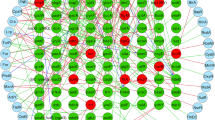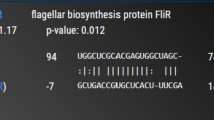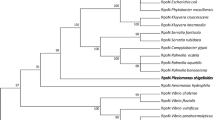Abstract
Nocardia farcinica is a Gram positive, filamentous bacterium, and is considered an opportunistic pathogen. In this study, the highly expressed genes in N. farcinica were predicted using the codon adaptation index (CAI) as a numerical estimator of gene expressivity. Using ribosomal protein (RP) genes as references, the top ∼ ∼10% of the genes were predicted to be the predicted highly expressed (PHX) genes in N. farcinica using a CAI cutoff of greater than 0.73. Consistent with earlier analysis of Streptomyces genomes, most of the PHX genes in N. farcinica were involved in various ‘house-keeping’ functions important for cell growth. However, 15 genes putatively involved in nocardial virulence were predicted as PHX genes in N. farcinica, which included genes encoding four Mce proteins, cyclopropane fatty acid synthase which is involved in the modification of cell wall which may be important for nocardia virulence, polyketide synthase PKS13 for mycolic acid synthesis and a non-ribosomal peptide synthetase involved in biosynthesis of a mycobactin-related siderophore. In addition, multiple genes involved in defense against reactive oxygen species (ROS) produced by the phagocyte were predicted with high expressivity, which included alkylhydroperoxide reductase (ahpC), catalase (katG), superoxide dismutase (sodF), thioredoxin, thioredoxin reductase, glutathione peroxidase, and peptide methionine sulfoxide reductase, suggesting that combating against ROS is essential for survival of N. farcinica in host cells. The study also showed that the distribution of PHX genes in the N. farcinica circular chromosome was uneven, with more PHX genes located in the regions close to replication initiation site. The results provided the first estimates of global gene expression patterns in N.␣farcinica, which will be useful in guiding experimental design for further investigations.
Similar content being viewed by others
References
Beaman B.L., Beaman L. (1994). Nocardia species: host-parasite relationships. Clin. Microbiol. Rev. 7:213–264
Bentley S.D., Chater K.F., Cerdeno-Tarraga A.M., 40 other authers. (2002). Complete genome sequence of the model actinomycete Streptomyces coelicolor A3(2). Nature 417:141–147
Birch A., Leiser A., Robinson J.A. (1993). Cloning, sequencing, and expression of the gene encoding methylmalonyl-coenzyme A mutase from Streptomyces cinnamonensis. J. Bacteriol. 175:3511–3519
Blanco G., Rodicio M.R., Puglia A.M., Mendez C., Thompson C.J., Salas J.A. (1994). Synthesis of ribosomal proteins during growth of Streptomyces coelicolor. Mol. Microbiol. 12:375–385
Chakraburtty R., Bibb M. (1997). The ppGpp synthetase gene (relA) of Streptomyces coelicolor A3(2) plays a conditional role in antibiotic production and morphological differentiation. J. Bacteriol. 179:5854–5861
Chitale S., Ehrt S., Kawamura I., Fujimura T., Shimono N., Anand N., Lu S., Cohen-Gould L., Riley L.W. (2001). Recombinant Mycobacterium tuberculosis protein associated with mammalian cell entry. Cell Microbiol. 3:247–254
Coghlan A., Wolfe K.H. (2000). Relationship of codon bias to mRNA concentration and protein length in Saccharomyces cerevisiae. Yeast 16:1131–1145
Domingue G.J. Sr, Woody H.B. (1997). Bacterial persistence and expression of disease. Clin. Microbiol. Rev. 10:320–344
Dos Reis M., Wernisch L., Savva R. (2003). Unexpected correlations between gene expression and codon usage bias from microarray data for the whole Escherichia coli K-12 genome. Nucleic Acids Res. 31:6976–6985
Eichel J., Chang Y.Y., Riesenberg D., Cronan J.E. (1999). Effect of ppGpp on Escherichia coli cyclopropane fatty acid synthesis is mediated through the RpoS sigma factor (σS). J. Bacteriol. 181:572–576
Gentry D.R., Hernandez V.J., Nygen L.H., Jensen D.B., Cashel M. (1993). Synthesis of the stationary-phase sigma factor σS is positively regulated by ppGpp. J Bacteriol 175:7982–7989
Haile Y., Bjune G., Wiker H.G. (2002). Expression of the mceA, esat-6 and hspX genes in Mycobacterium tuberculosis and their responses to aerobic conditions and to restricted oxygen supply. Microbiology 148:3881–3886
Huang J., Lih C.J., Pan K.H., Cohen S.N. (2001). Global analysis of growth phase responsive gene expression and regulation of antibiotic biosynthetic pathways in Streptomyces coelicolor using DNA microarrays. Genes Dev. 15:3183–3192
Hopwood D.A., Sherman D.H. (1990). Molecular genetics of polyketides and its comparison to fatty acid biosynthesis. Annu. Rev. Genet. 24:37–66
Hubble J.P., Cao T., Kjelstrom J.A., Koller W.C., Beaman B.L. (1995). Nocardia species as an etiologic agent in Parkinson’s disease: serological testing in a case-control study. J. Clin. Microbiol. 33:2768–2769
Ikeda H., Ishikawa J., Hanamoto K., 7 other authers. (2003). Complete genome sequence and comparative analysis of the industrial microorganism Streptomyces avermitilis. Nature Biotech. 21:526–531
Ikemura T. (1981). Correlation between the abundance of Escherichia coli transfer RNAs and the occurrence of the respective codons in its protein genes: a proposal for a synonymous codon choice that is optimal for the E. coli translational system. J. Mol. Biol. 151:389–409
Ikemura T. (1982). Correlation between the abundance of yeast transfer RNAs and the occurrence of the respective codons in protein genes. Differences in synonymous codon choice patterns of yeast and Escherichia coli with reference to the abundance of isoaccepting transfer RNAs. J. Mol. Biol. 158:573–97
Ishikawa J., Yamashita A., Mikami Y., Hoshino Y., Kurita H., Hotta K., Shiba T., Hattori M. (2004). The complete genomic sequence of Nocardia farcinica IFM 10152. Proc. Natl. Acad. Sci. (USA) 101:14925–14930
Javaly K., Horowitz H.W., Wormser G.P. (1992). Nocardiosis in patients with human immunodeficiency virus infection. Medicine (Baltimore) 71:128–138
Kageyama A., Yazawa K., Ishikawa J., Hotta K., Nishimura K., Mikami Y. (2004). Nocardial infections in Japan from 1992 to 2001, including the first report of infection by Nocardia transvalensis. Eur. J. Epidemiol. 19:383–389
Karlin S., Mrazek J. (2000). Predicted highly expressed genes of diverse prokaryotic genomes. J. Bacteriol. 182:5238–5250
Karlin S., Mrazek J., Campbell A., Kaiser D. (2001). Characterizations of highly expressed genes of four fast-growing bacteria. J. Bacteriol. 183:5025–5040
Karlin S., Brocchieri L., Campbell A., Cyert M., Mrazek J. (2005). Genomic and proteomic comparisons between bacterial and archaeal genomes and related comparisons with the yeast and fly genomes. Proc. Natl. Acad. Sci. USA 102:7309–7314
Knight R.D., Freeland S.J. and Landweber L.F. 2001. A simple model based on mutation and selection explains trends in codon and amino-acid usage and GC composition within and across genomes. Genome Biol. 2: RESEARCH0010
Lafay B., Atherton J.C., Sharp P.M. (2000). Absence of translationally selected synonymous codon usage bias in Helicobacter pylori. Microbiology. 146:851–60
Li C., Florova G., Akopiants K., Reynolds K.A. (2004). Crotonyl-coenzyme A reductase provides methylmalonyl-CoA precursors for monensin biosynthesis by Streptomyces cinnamonensis in an oil-based extended fermentation. Microbiology 150:3463–3472
Liu H., Reynolds K.A. (1999). Role of crotonyl coenzyme A reductase in determining the ratio of polyketides monensin A and monensin B produced by Streptomyces cinnamonensis. J. Bacteriol. 181:6806–6813
Martin-Galiano A.J., Wells J.M., de la Campa A.G. (2004). Relationship between codon biased genes, microarray expression values and physiological characteristics of Streptococcus pneumoniae. Microbiology 150:2313–2325
Médigue C., Rouxel T., Vigier P., Hénaut A., Danchin A. (1991). Evidence for horizontal gene transfer in Escherichia coli speciation. J. Mol. Biol. 222:851–856
Moskovitz J., Rahman M.A., Strassman J., Yancey S.O., Kushner S.R., Brot N., Weissbach H. (1995). Escherichia coli peptide methionine sulfoxide reductase gene: regulation of expression and role in protecting against oxidative damage. J. Bacteriol. 177:502–507
Moskovitz J., Berlett B.S., Poston J.M., Stadtman E.R. (1997). The yeast peptide-methionine sulfoxide reductase functions as an antioxidant in vivo. Proc. Natl. Acad. Sci. USA 94:9585–9589
Mrazek J., Bhaya D., Grossman A.R., Karlin S. (2001). Highly expressed and alien genes of the Synechocystis genome. Nucleic Acids Res. 29:1590–1601
Newton G.L., Arnold K., Price M.S., Sherrill C., Delcardayre S.B., Aharonowitz Y., Cohen G., Davies J., Fahey R.C., Davis C. (1996). Distribution of thiols in microorganisms: mycothiol is a major thiol in most actinomycetes. J. Bacteriol. 178:1990–1995
Okamoto S., Lezhava A., Hosaka T., Okamoto-Hosoya Y., Ochi K. (2003). Enhanced expression of S-adenosylmethionine synthetase causes overproduction of actinorhodin in Streptomyces coelicolor A3(2). J. Bacteriol. 185:601–609
Pan A., Dutta C., Das J. (1998). Codon usage in highly expressed genes of Haemophillus influenzae and Mycobacterium tuberculosis: translational selection versus mutational bias. Gene 215:405–413
Perriere G., Thioulouse J. (2002). Use and misuse of correspondence analysis in codon usage studies. Nucleic Acids Res. 30:4548–4555
Portevin D., De Sousa-D’Auria C., Houssin C., Grimaldi C., Chami M., Daffe M., Guilhot C. (2004). A polyketide synthase catalyzes the last condensation step of mycolic acid biosynthesis in mycobacteria and related organisms. Proc. Natl. Acad. Sci. USA 101:314–319
Quadri L.E.N., Sello J., Keating T.A., Weinreb P.H., Walsh C.T. (1998). Identification of a Mycobacterium tuberculosis gene cluster encoding the biosynthetic enzymes for assembly of the virulence-conferring siderophore mycobactin. Chem. Biol. 5:631–645
Rodionov D.A., Dubchak I., Arkin A., Alm E., Gelfand M.S. (2004). Reconstruction of regulatory and metabolic pathways in metal-reducing delta-proteobacteria. Genome Biol. 5: R90
Rao V., Fujiwara N., Porcelli S.A., Glickman M.S. (2005). Mycobacterium tuberculosis controls host innate immune activation through cyclopropane modification of a glycolipid effector molecule. J. Exp. Med. 201:535–543
Scharf C., Riethdorf S., Ernst H., Engelmann S., Volker U., Hecker M. (1998). Thioredoxin is an essential protein induced by multiple stresses in Bacillus subtilis. J. Bacteriol. 180:1869–1877
Sharp P.M. and Li W.H. (1986). An evolutionary perspective on synonymous codon usage in unicellular organisms. J. Mol. Evol. 24:28–38
Sharp P.M., Li W.H. (1987). The Codon Adaptation Index–a measure of directional synonymous codon usage bias, and its potential applications. Nucleic Acids Res. 15:1281–1295
Shigemori H., Komaki H., Yazawa K., Mikami Y., Nemoto A., Tanaka Y., Sasaki Y., Ishida T., Kobayashi J. (1998). Brasilicardin A A novel tricyclic metabolite with potent immunosuppressive activity from actinomycete Nocardia brasiliensis. J. Org. Chem. 63:6900–6904
Trotter E.W., Grant C.M. (2003). Non-reciprocal regulation of the redox state of the glutathione-glutaredoxin and thioredoxin systems. EMBO Rep. 4:184–188
Uziel O., Borovok I., Schreiber R., Cohen G., Aharonowitz Y. (2004). Transcriptional regulation of the Staphylococcus aureus thioredoxin and thioredoxin reductase genes in response to oxygen and disulfide stress. J. Bacteriol. 186:326–334
Venketaraman V., Dayaram Y.K., Talaue M.T., Connell N.D. (2005). Glutathione and nitrosoglutathione in macrophage defense against Mycobacterium tuberculosis. Infect. Immun. 73:1886–1889
Wayne L.G., Hayes L.G. (1998). Nitrate reduction as a marker for hypoxic shiftdown of Mycobacterium tuberculosis. Tuber. Lung. Dis. 79:127–132
Wu G., Culley D.E., Zhang W. (2005). Predicted highly expressed genes in the genomes of Streptomyces coelicolor and Streptomyces avermitilis and the implications for their metabolism. Microbiology 151:2175–2187
Wright F. (1990). The effective number of codons used in a gene. Gene 87:23–29
Zerbe-Burkhardt K., Ratnatilleke A., Philippon N., Birch A., Leiser A., Vrijbloed J.W., Hess D., Hunziker P., Robinson J.A. (1998). Cloning, sequencing, expression, and insertional inactivation of the gene for the large subunit of the coenzyme B12-dependent isobutyryl-CoA mutase from Streptomyces cinnamonensis. J. Biol. Chem. 273:6508–6517
Zhang W., Reynolds K.A. (2001). MeaA, a putative coenzyme B12-dependent mutase, provides methylmalonyl coenzyme A for monensin biosynthesis in Streptomyces cinnamonensis. J. Bacteriol. 183:2071–2080
Acknowledgements
Pacific Northwest National Laboratory is operated by Battelle Memorial Institute for the U.S. Department of Energy through contract DE-AC06-76RLO 1830.
Author information
Authors and Affiliations
Corresponding author
Electronic supplementary material
Rights and permissions
About this article
Cite this article
Wu, G., Nie, L. & Zhang, W. Predicted highly expressed genes in Nocardia farcinica and the implication for its primary metabolism and nocardial virulence. Antonie Van Leeuwenhoek 89, 135–146 (2006). https://doi.org/10.1007/s10482-005-9016-z
Received:
Accepted:
Published:
Issue Date:
DOI: https://doi.org/10.1007/s10482-005-9016-z




